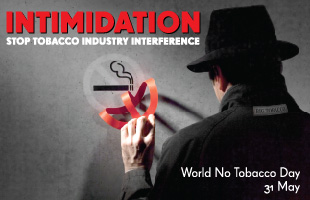May 29, 2012
Stanton A. Glantz, PhD
The theme of World No Tobacco Day (May 31) is "Tobacco Industry Interference"

The No on 29 campaign is a great example of the kind of "tobacco industry interference" that the WHO is highlighting in its materials for World No Tobacco Day.
The WHO's list of "Information sheet on tobacco industry interference" could have been written about the No on 29 campaign:
1. Manoeuvering to hijack the political and legislative process
The tobacco industry has been highly resourceful in undermining governments’ efforts to protect public health. Tobacco companies have become expert in creating and exploiting legislative loopholes and manoeuvering with lobbyists to effectively influence law-making.
2. Exaggerating the economic importance of the industry
Employment, tax contributions and other economic indicators are frequently used by the tobacco industry to demonstrate their contribution to the economy of a country. But the figures provided by the companies do not only exaggerate the economic importance of the industry but also ignore the social, environmental and health costs caused by tobacco and tobacco products.
3. Manipulating public opinion to gain the appearance of respectability
Tobacco kills – but the tobacco industry has developed a range of tricks to manipulate public opinion. By investing funds in youth programmes or unrelated social causes, such as disaster relief and nature conservation groups, tobacco companies shift the focus away from their deadly products and gain a veneer of social respectability.
4. Fabricating support through front groups
Due to its isolation, the tobacco industry needs to simulate support. The tobacco industry creates and uses phony “grassroots” groups that support its interests. Typically, these groups focus on individual freedom, the alleged economic damage caused by smoke-free policies or feigned controversy about second-hand smoke.
5. Discrediting proven science
Sowing the seeds of doubt on the scientific evidence about the harm caused by tobacco and second-hand smoke is a popular tactic used by the tobacco industry. In order to weaken tobacco control legislation, the industry sparks controversy to distract and confuse the public and governments.
6. Intimidating governments with litigation or the threat of litigation
Threats of legal action are a popular tactic to intimidate governments that introduce effective tobacco control policies. As domestic courts, based on the WHO Framework Convention on Tobacco Control, increasingly rule against the tobacco industry in cases brought against governments, the companies use bilateral and trade agreements to pursue states in international courts. The aim: to deter other countries from introducing effective tobacco control measures.
Check out all the excellent materials the WHO has prepared here.

Add new comment